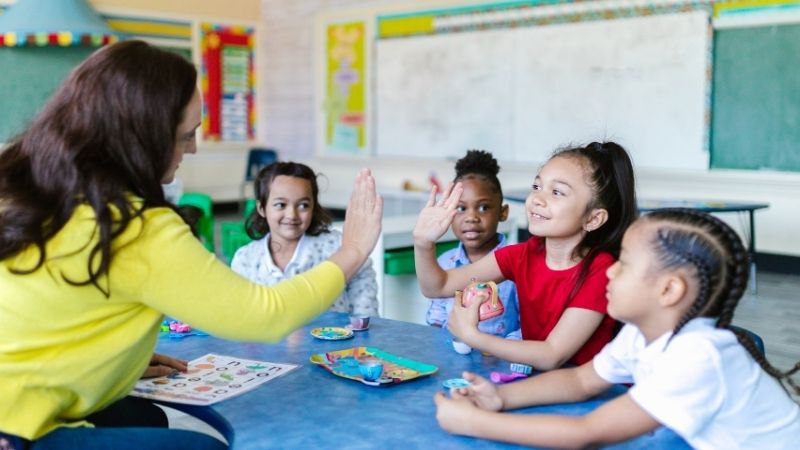
Collaboration among students is a fundamental aspect of contemporary education. In an era where technology dominates various aspects of our lives, the integration of online tools has become increasingly prevalent in fostering effective teamwork and collaborative learning.
This article aims to explore how group projects online, peer feedback tools, shared documents, video collaboration, and online discussion boards contribute to enhancing student collaboration and facilitating interactive learning.
By examining the benefits and potential drawbacks of these collaboration tools, educators can better understand their implications for promoting effective student teamwork and engagement in the digital age.
Key Takeaways
- Online collaboration tools enable students to work together regardless of geographical limitations or time constraints.
- Peer feedback tools promote active learning, critical thinking, and self-reflection.
- Clear guidelines and criteria for evaluation ensure constructive and helpful feedback in peer feedback processes.
- Technology tools like shared documents and video collaboration platforms enhance collaboration and problem-solving in group projects.
The Power of Group Projects Online
The utilization of group projects conducted online has been shown to be a powerful tool in promoting collaborative learning and enhancing student teamwork. Online collaboration provides students with the opportunity to work together virtually, regardless of geographical limitations or time constraints. It allows for flexible scheduling and encourages active participation from all members of the group.
Virtual teamwork fosters the development of important skills such as communication, problem-solving, and conflict resolution. Additionally, online collaboration enables students to leverage technology tools that facilitate effective group work, such as shared documents and video collaboration platforms. These tools allow for real-time contributions and feedback exchange, promoting a sense of shared responsibility among team members.
Overall, group projects conducted online offer numerous benefits in terms of fostering collaborative learning experiences and enhancing student teamwork skills in a virtual environment.
This discussion will focus on the benefits, effectiveness, and strategies for maximizing peer feedback in an academic setting.

Peer feedback offers several advantages, such as promoting active learning, providing diverse perspectives, and enhancing critical thinking skills.
Effective peer feedback entails clear guidelines, constructive criticism, and timely delivery to maximize its impact on student learning.
To optimize the benefits of peer feedback, educators can implement structured rubrics, promote a supportive classroom environment, and provide opportunities for reflection and revision based on received feedback.
Benefits of Peer Feedback
Peer feedback tools in online education facilitate the improvement of students' critical thinking skills and provide opportunities for self-reflection. These tools play a crucial role in improving communication among students by allowing them to engage in constructive discussions about their work.
Through peer feedback, students are encouraged to critically analyze their peers' work, identify strengths and weaknesses, and provide suggestions for improvement. This process promotes critical thinking as students learn to evaluate and assess the quality of their own work as well as others'.
Moreover, peer feedback tools also offer opportunities for self-reflection, enabling students to gain insights into their own learning processes and areas for growth. By actively participating in giving and receiving feedback, students develop a deeper understanding of the subject matter while honing their analytical skills.
Effective peer feedback can further enhance these benefits by providing clear guidelines and criteria for evaluation, ensuring that the feedback is constructive and helpful for all parties involved.

Effective Peer Feedback
Effective peer feedback fosters a culture of critical evaluation and improvement among students, promoting their analytical skills and self-reflection. Peer feedback plays a crucial role in improving the quality of student work by providing additional perspectives and insights. It offers an opportunity for students to receive constructive criticism and learn from their peers' expertise.
By engaging in the process of giving and receiving feedback, students are able to develop essential skills such as active listening, effective communication, and empathy. Additionally, peer feedback promotes engagement as it encourages students to actively participate in the learning process. Students become more invested in their work when they know that their peers will be evaluating it, leading to increased effort and motivation.
Overall, effective peer feedback enhances the learning experience by creating a collaborative environment where students can continuously refine their work and promote each other's growth.
Maximizing Peer Feedback
To optimize the impact of peer feedback, it is essential to establish clear guidelines and criteria for evaluating student work. Maximizing feedback effectiveness requires implementing effective peer feedback strategies.
One such strategy is providing students with specific criteria or rubrics that outline the expected standards for evaluation. This helps students understand what aspects of their peers' work they should focus on when providing feedback.
Additionally, encouraging students to give both positive and constructive feedback can enhance the overall quality of peer evaluations.
Peer feedback can also be made more effective by incorporating opportunities for reflection and revision based on the received feedback. By allowing students to reflect on their own work in light of the feedback received, they can make meaningful revisions that lead to improved learning outcomes.

Enhancing Collaboration With Shared Documents
Collaborative learning is facilitated through the utilization of shared documents, which allow students to simultaneously work on projects and provide input in a structured manner. Shared documents offer several benefits that improve efficiency and promote engagement in collaborative learning environments:
Real-time collaboration: Shared documents enable students to work together simultaneously, eliminating the need for offline file sharing or waiting for feedback. This real-time collaboration fosters efficient teamwork as students can contribute and edit content concurrently.
Version control: Shared document platforms often provide version control features, allowing students to track changes and revert back to previous versions if needed. This enhances efficiency by preventing confusion and ensuring everyone is working on the most up-to-date version.
Commenting and feedback: Shared documents enable students to comment directly on specific sections or paragraphs, facilitating peer feedback in a structured manner. This promotes engagement as it encourages active participation, constructive criticism, and collaborative problem-solving.
Exploring the Potential of Video Collaboration
Video collaboration has become an increasingly popular tool for enhancing remote teamwork in various industries. The benefits of video collaboration include improved communication, increased productivity, and enhanced engagement among team members.
This discussion will explore the potential of video collaboration in facilitating remote teamwork and the ways it can contribute to a more efficient and effective work environment.
Benefits of Video Collaboration
The effectiveness of video collaboration as a tool for enhancing student teamwork and collaborative learning has been widely acknowledged in educational research. Virtual communication offers several benefits that contribute to the success of remote collaboration:

Increased accessibility: Video collaboration allows students to connect and work together regardless of their physical location. This eliminates geographical barriers and enables participation from diverse backgrounds.
Enhanced engagement: The use of video technology promotes active involvement among students, as it provides a visual representation of participants and encourages face-to-face interaction. This fosters greater engagement and motivation to actively contribute to group discussions.
Improved communication and understanding: Video collaboration enables real-time communication, allowing students to exchange ideas, share perspectives, and provide instant feedback. This enhances the clarity of information exchange, promotes effective problem-solving, and facilitates better comprehension among team members.
Overall, the advantages offered by video collaboration make it an invaluable tool for promoting student teamwork and facilitating collaborative learning experiences in an online environment.
Enhancing Remote Teamwork
The benefits of video collaboration have been explored in the previous subtopic. In this section, we will delve into how remote communication and virtual collaboration tools can enhance teamwork in a remote setting.
With the increasing popularity of online learning and remote work environments, it is crucial to find effective ways to facilitate student teamwork and collaborative learning. Remote communication tools such as instant messaging platforms and video conferencing software allow students to connect with their peers regardless of geographical distances.
Virtual collaboration platforms provide features such as shared documents, project management tools, and online discussion boards that enable students to collaborate on group projects effectively. These tools not only foster seamless communication but also promote active participation, idea sharing, and peer feedback among team members.

Fostering Discussion and Learning With Online Discussion Boards
Online discussion boards serve as a platform for fostering student engagement, facilitating peer-to-peer interaction, and promoting collaborative learning in an online environment.
Interactive engagement: Online discussion boards provide students with the opportunity to actively engage in their learning process. Through discussions and dialogue, students can share their thoughts, ask questions, and challenge each other's ideas.
Online dialogue: The asynchronous nature of online discussion boards allows students to participate in meaningful conversations at their own pace. This encourages thoughtful reflection and deeper understanding of the topics being discussed.
Enhanced collaboration: Discussion boards promote collaborative learning by enabling students to work together on assignments or projects. They can share resources, offer feedback to their peers, and collectively problem-solve. This fosters a sense of community and encourages active participation among students.
Maximizing Student Teamwork Through Collaborative Learning
Maximizing student teamwork through collaborative learning can be achieved by effectively utilizing platforms that facilitate meaningful dialogue and encourage active participation among students. In order to promote active engagement and enhance the learning experience, educators can employ various strategies and tools.
Group projects conducted online provide opportunities for students to collaborate virtually, enabling them to work together regardless of physical distance or time constraints. Peer feedback tools allow students to provide constructive criticism and support their peers' learning process, fostering a sense of community and shared responsibility.
Shared documents enable real-time collaboration, allowing students to co-create content and develop critical thinking skills. Video collaboration platforms offer synchronous communication, providing an immersive experience that encourages active participation.

Online discussion boards serve as forums for exchanging ideas, promoting critical analysis, and enhancing understanding through peer interaction. By leveraging these collaborative tools effectively, educators can maximize student engagement and foster a culture of active participation in the learning environment.
Frequently Asked Questions
What Are the Potential Drawbacks of Using Group Projects Online for Collaborative Learning?
Potential challenges of using group projects online for collaborative learning include decreased student engagement due to lack of face-to-face interaction, difficulty coordinating schedules and communication, and inequitable distribution of workload among team members.
How Can Instructors Effectively Monitor and Assess Student Participation in Online Group Projects?
Instructors can effectively monitor and assess student participation in online group projects by providing timely feedback and using various assessment methods. One interesting statistic reveals that students who receive instructor feedback are more likely to actively engage in collaborative learning.
Privacy concerns may arise when using peer feedback tools in collaborative learning environments, particularly regarding data protection. It is important for instructors and institutions to implement appropriate measures to ensure the privacy and security of student information.
What Are Some Best Practices for Using Shared Documents to Enhance Collaboration?
Using shared documents effectively is crucial for enhancing collaboration in student teamwork. Collaborative document editing allows for real-time contribution, organization, and access to information, promoting efficient and cohesive group work.
What are the benefits of virtual collaboration in remote learning? How can strategies for engaging students in video collaboration activities be developed effectively to promote teamwork and interactive learning in online environments?
 Careers in EducationElementary EducationHigh School EducationEducational TechnologyTeaching StrategiesSpecial EducationPrivacy PolicyTerms And Conditions
Careers in EducationElementary EducationHigh School EducationEducational TechnologyTeaching StrategiesSpecial EducationPrivacy PolicyTerms And Conditions
